Input interpretation

H_2SO_4 sulfuric acid + CO carbon monoxide ⟶ H_2O water + CO_2 carbon dioxide + SO_2 sulfur dioxide
Balanced equation
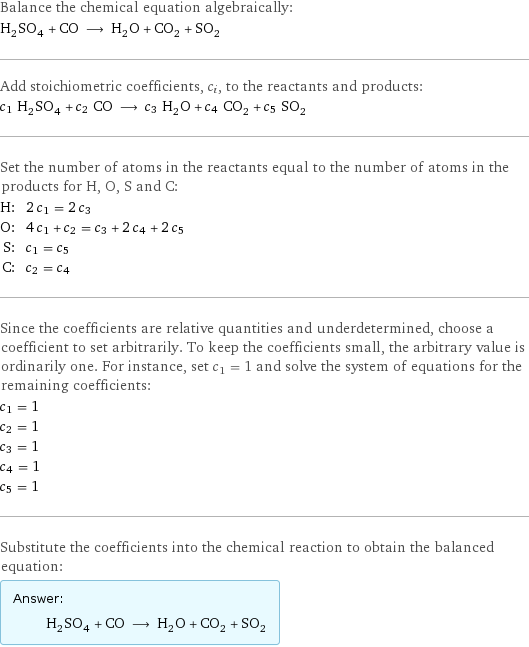
Balance the chemical equation algebraically: H_2SO_4 + CO ⟶ H_2O + CO_2 + SO_2 Add stoichiometric coefficients, c_i, to the reactants and products: c_1 H_2SO_4 + c_2 CO ⟶ c_3 H_2O + c_4 CO_2 + c_5 SO_2 Set the number of atoms in the reactants equal to the number of atoms in the products for H, O, S and C: H: | 2 c_1 = 2 c_3 O: | 4 c_1 + c_2 = c_3 + 2 c_4 + 2 c_5 S: | c_1 = c_5 C: | c_2 = c_4 Since the coefficients are relative quantities and underdetermined, choose a coefficient to set arbitrarily. To keep the coefficients small, the arbitrary value is ordinarily one. For instance, set c_1 = 1 and solve the system of equations for the remaining coefficients: c_1 = 1 c_2 = 1 c_3 = 1 c_4 = 1 c_5 = 1 Substitute the coefficients into the chemical reaction to obtain the balanced equation: Answer: | | H_2SO_4 + CO ⟶ H_2O + CO_2 + SO_2
Structures

+ ⟶ + +
Names

sulfuric acid + carbon monoxide ⟶ water + carbon dioxide + sulfur dioxide
Reaction thermodynamics
Enthalpy
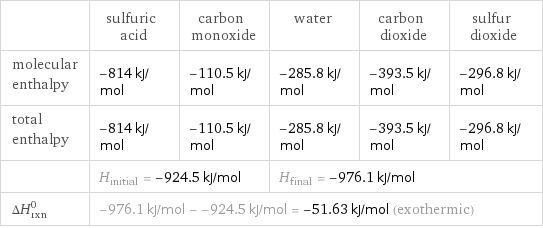
| sulfuric acid | carbon monoxide | water | carbon dioxide | sulfur dioxide molecular enthalpy | -814 kJ/mol | -110.5 kJ/mol | -285.8 kJ/mol | -393.5 kJ/mol | -296.8 kJ/mol total enthalpy | -814 kJ/mol | -110.5 kJ/mol | -285.8 kJ/mol | -393.5 kJ/mol | -296.8 kJ/mol | H_initial = -924.5 kJ/mol | | H_final = -976.1 kJ/mol | | ΔH_rxn^0 | -976.1 kJ/mol - -924.5 kJ/mol = -51.63 kJ/mol (exothermic) | | | |
Gibbs free energy
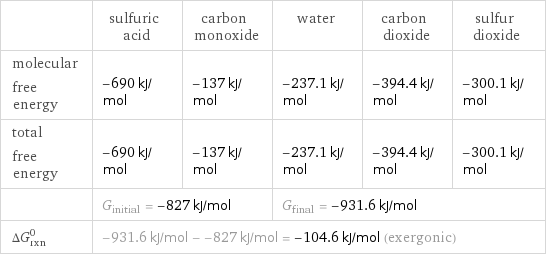
| sulfuric acid | carbon monoxide | water | carbon dioxide | sulfur dioxide molecular free energy | -690 kJ/mol | -137 kJ/mol | -237.1 kJ/mol | -394.4 kJ/mol | -300.1 kJ/mol total free energy | -690 kJ/mol | -137 kJ/mol | -237.1 kJ/mol | -394.4 kJ/mol | -300.1 kJ/mol | G_initial = -827 kJ/mol | | G_final = -931.6 kJ/mol | | ΔG_rxn^0 | -931.6 kJ/mol - -827 kJ/mol = -104.6 kJ/mol (exergonic) | | | |
Entropy
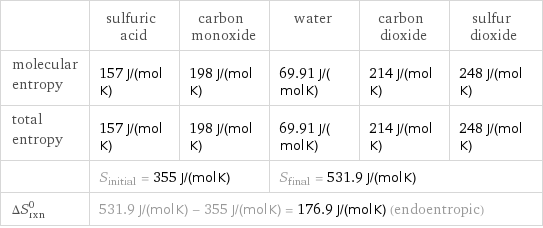
| sulfuric acid | carbon monoxide | water | carbon dioxide | sulfur dioxide molecular entropy | 157 J/(mol K) | 198 J/(mol K) | 69.91 J/(mol K) | 214 J/(mol K) | 248 J/(mol K) total entropy | 157 J/(mol K) | 198 J/(mol K) | 69.91 J/(mol K) | 214 J/(mol K) | 248 J/(mol K) | S_initial = 355 J/(mol K) | | S_final = 531.9 J/(mol K) | | ΔS_rxn^0 | 531.9 J/(mol K) - 355 J/(mol K) = 176.9 J/(mol K) (endoentropic) | | | |
Equilibrium constant
![Construct the equilibrium constant, K, expression for: H_2SO_4 + CO ⟶ H_2O + CO_2 + SO_2 Plan: • Balance the chemical equation. • Determine the stoichiometric numbers. • Assemble the activity expression for each chemical species. • Use the activity expressions to build the equilibrium constant expression. Write the balanced chemical equation: H_2SO_4 + CO ⟶ H_2O + CO_2 + SO_2 Assign stoichiometric numbers, ν_i, using the stoichiometric coefficients, c_i, from the balanced chemical equation in the following manner: ν_i = -c_i for reactants and ν_i = c_i for products: chemical species | c_i | ν_i H_2SO_4 | 1 | -1 CO | 1 | -1 H_2O | 1 | 1 CO_2 | 1 | 1 SO_2 | 1 | 1 Assemble the activity expressions accounting for the state of matter and ν_i: chemical species | c_i | ν_i | activity expression H_2SO_4 | 1 | -1 | ([H2SO4])^(-1) CO | 1 | -1 | ([CO])^(-1) H_2O | 1 | 1 | [H2O] CO_2 | 1 | 1 | [CO2] SO_2 | 1 | 1 | [SO2] The equilibrium constant symbol in the concentration basis is: K_c Mulitply the activity expressions to arrive at the K_c expression: Answer: | | K_c = ([H2SO4])^(-1) ([CO])^(-1) [H2O] [CO2] [SO2] = ([H2O] [CO2] [SO2])/([H2SO4] [CO])](../image_source/fcaaa15faaed4adaccbed5559e472f21.png)
Construct the equilibrium constant, K, expression for: H_2SO_4 + CO ⟶ H_2O + CO_2 + SO_2 Plan: • Balance the chemical equation. • Determine the stoichiometric numbers. • Assemble the activity expression for each chemical species. • Use the activity expressions to build the equilibrium constant expression. Write the balanced chemical equation: H_2SO_4 + CO ⟶ H_2O + CO_2 + SO_2 Assign stoichiometric numbers, ν_i, using the stoichiometric coefficients, c_i, from the balanced chemical equation in the following manner: ν_i = -c_i for reactants and ν_i = c_i for products: chemical species | c_i | ν_i H_2SO_4 | 1 | -1 CO | 1 | -1 H_2O | 1 | 1 CO_2 | 1 | 1 SO_2 | 1 | 1 Assemble the activity expressions accounting for the state of matter and ν_i: chemical species | c_i | ν_i | activity expression H_2SO_4 | 1 | -1 | ([H2SO4])^(-1) CO | 1 | -1 | ([CO])^(-1) H_2O | 1 | 1 | [H2O] CO_2 | 1 | 1 | [CO2] SO_2 | 1 | 1 | [SO2] The equilibrium constant symbol in the concentration basis is: K_c Mulitply the activity expressions to arrive at the K_c expression: Answer: | | K_c = ([H2SO4])^(-1) ([CO])^(-1) [H2O] [CO2] [SO2] = ([H2O] [CO2] [SO2])/([H2SO4] [CO])
Rate of reaction
![Construct the rate of reaction expression for: H_2SO_4 + CO ⟶ H_2O + CO_2 + SO_2 Plan: • Balance the chemical equation. • Determine the stoichiometric numbers. • Assemble the rate term for each chemical species. • Write the rate of reaction expression. Write the balanced chemical equation: H_2SO_4 + CO ⟶ H_2O + CO_2 + SO_2 Assign stoichiometric numbers, ν_i, using the stoichiometric coefficients, c_i, from the balanced chemical equation in the following manner: ν_i = -c_i for reactants and ν_i = c_i for products: chemical species | c_i | ν_i H_2SO_4 | 1 | -1 CO | 1 | -1 H_2O | 1 | 1 CO_2 | 1 | 1 SO_2 | 1 | 1 The rate term for each chemical species, B_i, is 1/ν_i(Δ[B_i])/(Δt) where [B_i] is the amount concentration and t is time: chemical species | c_i | ν_i | rate term H_2SO_4 | 1 | -1 | -(Δ[H2SO4])/(Δt) CO | 1 | -1 | -(Δ[CO])/(Δt) H_2O | 1 | 1 | (Δ[H2O])/(Δt) CO_2 | 1 | 1 | (Δ[CO2])/(Δt) SO_2 | 1 | 1 | (Δ[SO2])/(Δt) (for infinitesimal rate of change, replace Δ with d) Set the rate terms equal to each other to arrive at the rate expression: Answer: | | rate = -(Δ[H2SO4])/(Δt) = -(Δ[CO])/(Δt) = (Δ[H2O])/(Δt) = (Δ[CO2])/(Δt) = (Δ[SO2])/(Δt) (assuming constant volume and no accumulation of intermediates or side products)](../image_source/5c5d6809bd91de9006a57a2bc7a65e13.png)
Construct the rate of reaction expression for: H_2SO_4 + CO ⟶ H_2O + CO_2 + SO_2 Plan: • Balance the chemical equation. • Determine the stoichiometric numbers. • Assemble the rate term for each chemical species. • Write the rate of reaction expression. Write the balanced chemical equation: H_2SO_4 + CO ⟶ H_2O + CO_2 + SO_2 Assign stoichiometric numbers, ν_i, using the stoichiometric coefficients, c_i, from the balanced chemical equation in the following manner: ν_i = -c_i for reactants and ν_i = c_i for products: chemical species | c_i | ν_i H_2SO_4 | 1 | -1 CO | 1 | -1 H_2O | 1 | 1 CO_2 | 1 | 1 SO_2 | 1 | 1 The rate term for each chemical species, B_i, is 1/ν_i(Δ[B_i])/(Δt) where [B_i] is the amount concentration and t is time: chemical species | c_i | ν_i | rate term H_2SO_4 | 1 | -1 | -(Δ[H2SO4])/(Δt) CO | 1 | -1 | -(Δ[CO])/(Δt) H_2O | 1 | 1 | (Δ[H2O])/(Δt) CO_2 | 1 | 1 | (Δ[CO2])/(Δt) SO_2 | 1 | 1 | (Δ[SO2])/(Δt) (for infinitesimal rate of change, replace Δ with d) Set the rate terms equal to each other to arrive at the rate expression: Answer: | | rate = -(Δ[H2SO4])/(Δt) = -(Δ[CO])/(Δt) = (Δ[H2O])/(Δt) = (Δ[CO2])/(Δt) = (Δ[SO2])/(Δt) (assuming constant volume and no accumulation of intermediates or side products)
Chemical names and formulas
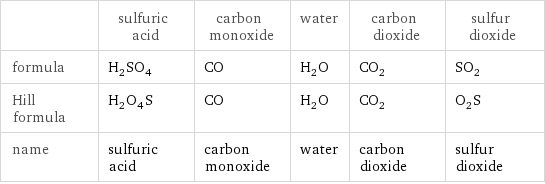
| sulfuric acid | carbon monoxide | water | carbon dioxide | sulfur dioxide formula | H_2SO_4 | CO | H_2O | CO_2 | SO_2 Hill formula | H_2O_4S | CO | H_2O | CO_2 | O_2S name | sulfuric acid | carbon monoxide | water | carbon dioxide | sulfur dioxide